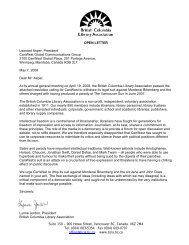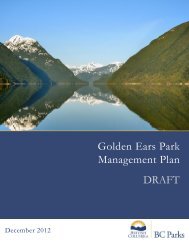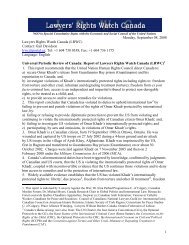Create successful ePaper yourself
Turn your PDF publications into a flip-book with our unique Google optimized e-Paper software.
REBECCA BLISSETT PHOTO / JAMIE ROGERS MODEL<br />
SAY WHAT?<br />
COOL TECHNOLOGY MAY<br />
BE AGING YOUR EARS<br />
BY HELENA BRYAN<br />
| GEORGIA STRAIGHT MIND BODY SOUL | | FALL 2005 |<br />
6<br />
young people everywhere likely have<br />
Hip no idea that their oh-so-cool iPods and<br />
other MP3 players could be hurtling them toward<br />
middle age faster than driving the family<br />
minivan. According to an expert in the area<br />
of hearing amplifi cation at Indiana’s Purdue<br />
University, the almost constant use of portable<br />
music devices and cellphones by university and<br />
college students may be behind a disturbing<br />
increase in hearing loss in young people. In a<br />
widely reported warning, Robert Novak, director<br />
of clinical education in audiology at Purdue,<br />
says the loss is comparable to that normally<br />
seen only in middle-aged adults.<br />
Novak is not the only one with serious concerns.<br />
A long-term Argentinean study, the results<br />
of which ran in the February 2005 issue of the International<br />
Journal of Audiology, was designed<br />
to explain the high percentage of the country’s<br />
20- to 25-year-olds who failed pre-employment<br />
medical examinations because of hearing loss,<br />
despite having no history of ear disease.<br />
The study pointed the fi nger at various sources<br />
of recreational noise, including live concerts, stereos,<br />
dance clubs, and portable music devices.<br />
Vancouver audiologist Mark Hanson told the<br />
<strong>Georgia</strong> <strong>Straight</strong> during a telephone interview<br />
that he isn’t surprised by the fi ndings. “I see<br />
more and more younger people in my private<br />
practice concerned about hearing loss,” he<br />
said. The surging popularity of portable audio<br />
devices such as iPods increases the risk of hearing<br />
loss for two reasons, Hanson said. They are<br />
convenient, so people are listening to them<br />
more often; and, because the earphones are inserted<br />
right into the ear, they put more pressure<br />
on the eardrum itself.<br />
As assistant professor at UBC’s School of Audiology<br />
and Speech Sciences, Navid Shahnaz is<br />
not only an expert on hearing and hearing loss,<br />
he witnesses enough campus culture to make<br />
observations about the use of personal listening<br />
devices. “It certainly seems widespread,” he said<br />
from his UBC offi ce.<br />
Recent UBC graduate Scott Lyon goes even further.<br />
“There’s an iPod explosion,” he said in a recent<br />
phone interview. “They are ever present and<br />
omnipresent. And everybody who uses them<br />
raves about them, so I don’t think they’re going to<br />
go away anytime soon.”<br />
The maximum decibel level on such devices is<br />
usually 105, and the listener’s tendency is to turn<br />
the sound on high to mask other noises such as<br />
traffi c or conversation, noted Shahnaz. “I see students<br />
getting on and off the buses with them on.<br />
And buses are noisy, so they’re probably pumping<br />
up the volume to the maximum.” Noise levels<br />
aren’t helped by the hordes of cellphone users<br />
who seem to feel they need to yell to be heard at<br />
the other end.<br />
Decibels are a measure of the pressure sound<br />
exerts on a surface; that is, the intensity of a sound.<br />
To put 105 decibels in perspective, consider that<br />
the average conversation is 60 decibels, traffi c<br />
noise is 80 decibels, and a power saw is 110.<br />
According to Canadian occupational law—<br />
which Shahnaz believes is too liberal as it favours<br />
the employer, not the employee—the<br />
allowable exposure limit without ear protection<br />
for an 85-decibel sound is eight hours. He<br />
pointed out that it wouldn’t be a stretch to think<br />
that increasing the decibels just a little wouldn’t<br />
hurt. But with every three-decibel increase, the<br />
amount of pressure hitting the eardrum doubles;<br />
and the allowable time without protection<br />
is halved. So, at 88 decibels, the allowable exposure<br />
time is four hours; at 91 decibels, it’s two<br />
hours; at 94 decibels it’s one hour, and so on.<br />
At 105 decibels, the allowable exposure time<br />
is about four minutes—barely enough time to<br />
hear out one whole tune.<br />
“Even at the 85-decibel level, you’re causing<br />
damage to the delicate hair cells in the inner<br />
ear,” Shahnaz said. He likens these cells to<br />
blades of grass. If people step on the grass a<br />
couple of times, it will gradually stand straight<br />
up again. But if they continue to tread on it, the<br />
blades will eventually fl atten and won’t bounce<br />
back. Likewise, a couple of noise exposures<br />
won’t permanently damage the hair cells. But if<br />
they are constantly bombarded, they’ll eventually<br />
become detached, resulting in permanent<br />
hearing loss because the cells don’t regenerate.<br />
The ability to hear high frequencies—birdsong<br />
for example—will go fi rst, gradually expanding<br />
to the lower frequencies. In addition, a side effect<br />
called tinnitus may take hold, in which the<br />
hair cells themselves start to emit a ringing or<br />
buzzing sound. At the very least, says Shahnaz,<br />
tinnitus is an annoyance; at worst, it can disturb<br />
sleep and lead to depression.<br />
The impact of hearing loss goes well beyond<br />
the ear, both Shahnaz and Hanson emphasize. It<br />
can be socially isolating and affect performance<br />
at school and work. Students with professors who<br />
talk quickly or with an accent can suffer academically.<br />
That romantic dinner for two might not be<br />
so romantic when the words “I love you” aren’t<br />
heard above the noise of the restaurant. And a<br />
fi nancial planner or real estate agent who can’t<br />
distinguish between a “two” and a “three” could<br />
lose somebody a lot of money.<br />
Apart from tossing their iPods and other portables<br />
into the bin, how can kids protect their delicate<br />
hair cells from permanent damage? Hanson,<br />
who himself is not averse to using a Walkman when<br />
he goes jogging, suggests using earphones—the<br />
kind that sit on top of the ear—instead of the ear<br />
buds that fi t inside the ear. They can also turn down<br />
the volume. While that last piece of advice won’t<br />
be music to the ears of most young rock fans, their<br />
ability to hear the music they love so much may<br />
very well depend on it. -







